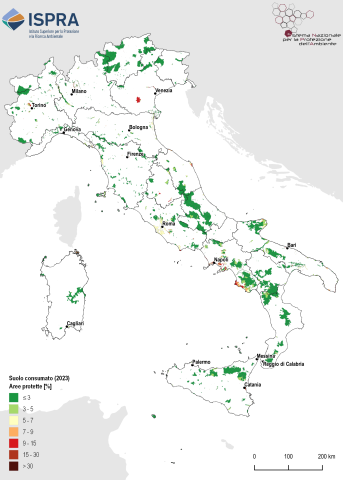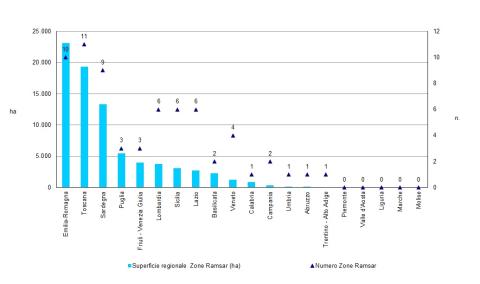Aree
DISTRIBUTION OF ECOLOGICAL VALUE ACCORDING TO CARTA DELLA NATURA
Data aggiornamento scheda:
The indicator, based on data processed within the Carta della Natura project, shows the distribution of Ecological Value (VE) across 17 Italian regions, providing a representation categorized into different classes. Ecological Value is understood as a synonym for natural significance and is calculated—starting from the regional habitat maps—for each mapped polygon, excluding those referring to built environments and fully urbanized areas. This indicator offers an overview of the environmental mosaic within various regional contexts, highlighting high-value areas, including their protection status. The analysis presents the percentage of protected areas in each region and the composition of protected and unprotected zones in terms of Ecological Value. The protected areas system (EUAP areas, Natura 2000 sites, and Ramsar areas) covers territories characterized by the highest Ecological Value classes but still leaves significant portions outside protected areas.
SOIL CONSUMPTION IN PROTECTED AREAS
Data aggiornamento scheda:

Within the areas included in the EUAP (Official List of Protected Areas), the total soil consumption in 2023 amounted to 58,601 hectares (1.9% of the protected territory). The soil consumption recorded between 2022 and 2023 was nearly 70 hectares. The highest values were observed in Campania (3.8%) and Veneto (3.2%), the only regions exceeding the 3% threshold of consumed territory within protected areas. Overall, between 2006 and 2023, a total of 1,767 hectares were lost within Italian protected areas.
NATURA 2000 NETWORK
Data aggiornamento scheda:
The Natura 2000 Network in Italy consists of 2,646 sites, covering a total area, net of overlaps, of 5,845,078 hectares on land, equivalent to 19.4% of the national territory, and 2,301,047 hectares at sea, corresponding to 6.4% of territorial waters (data updated to December 2023). A total of 643 Special Protection Areas (SPAs) and 2,364 Sites of Community Importance-Special Areas of Conservation (SCI-SACs) have been designated (of which 361 are SCI-SACs coinciding with SPAs). In December 2022, the sites numbered 2,639, with an increase of 7 units in the past year and an expansion of 163 hectares on land and 229,358 hectares at sea. The coverage percentages of the Natura 2000 Network vary across Italian regions and autonomous provinces, ranging from 12% to 36% on land and from less than 1% to 30% at sea.
The national coverage of the Network is significant in relation to the targets of the EU Biodiversity Strategy for 2030 (SEB2030), which calls for expanding protected areas in the EU to reach at least 30% of terrestrial and 30% of marine areas. The SEB2030 target includes all areas subject to protection measures, such as Natura 2000 sites, National and Regional Parks, and other protected areas. At the regional level, Abruzzo and Valle d’Aosta meet the SEB2030 target, with Natura 2000 sites covering 36% and 30% of their territories, respectively. Other regions approaching the target include the Autonomous Province of Trento (28%), Molise (27%), Campania (27%), and Liguria (26%). The protection percentages of Natura 2000 marine sites are lower, with only Puglia (30%) and Tuscany (27%) having protection levels close to the target.
WETLANDS OF INTERNATIONAL IMPORTANCE
Data aggiornamento scheda:

The Italian wetlands currently included in the official list of sites under the Ramsar Convention are 57, covering a total of 72,288 hectares. Additionally, three Ministerial Decrees were issued in 2011, 2013, and 2016 for the establishment of nine more areas. In total, the 66 Italian Ramsar sites (57 designated and 9 in the process of designation) are distributed across 15 regions, covering 79,826 hectares. The regions with the largest and most numerous areas are Emilia-Romagna (10 areas, 23,112 ha), Tuscany (11 areas, 19,306 ha), and Sardinia (9 areas, 13,308 ha).
The level of implementation of protection and management measures for these areas is not sufficiently known, despite being essential to ensure the conservation of habitats, flora, and fauna.